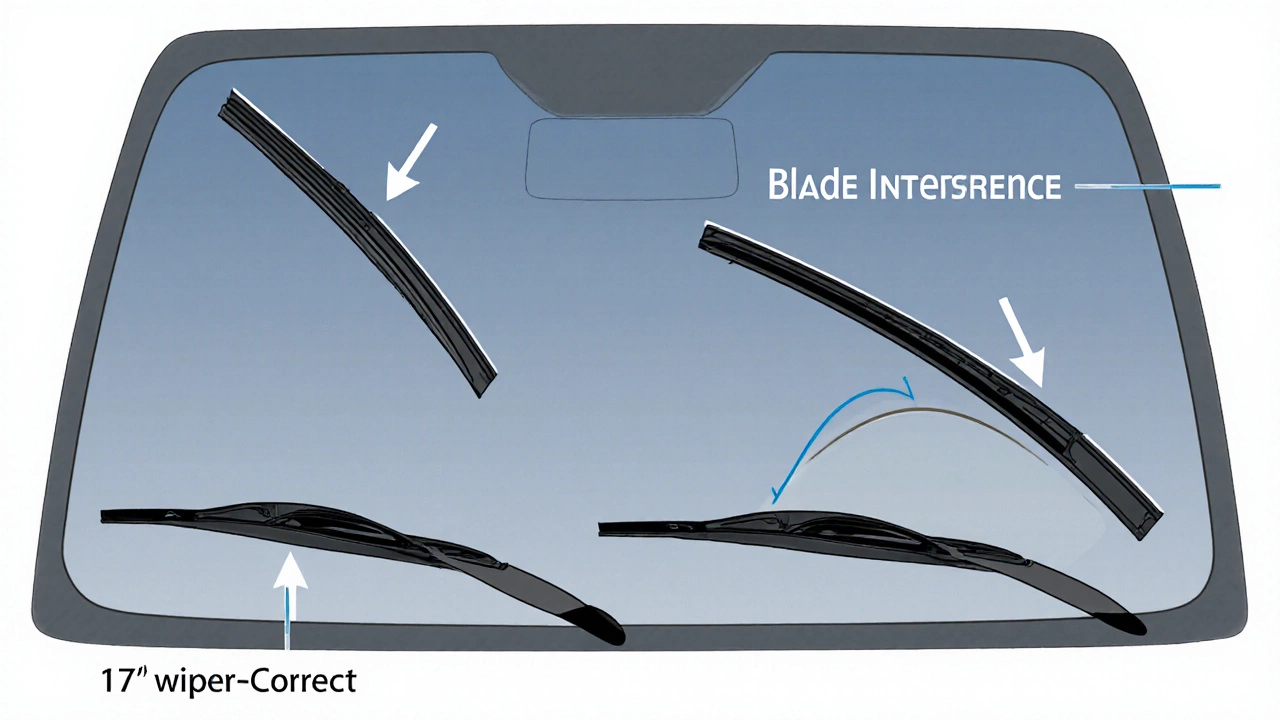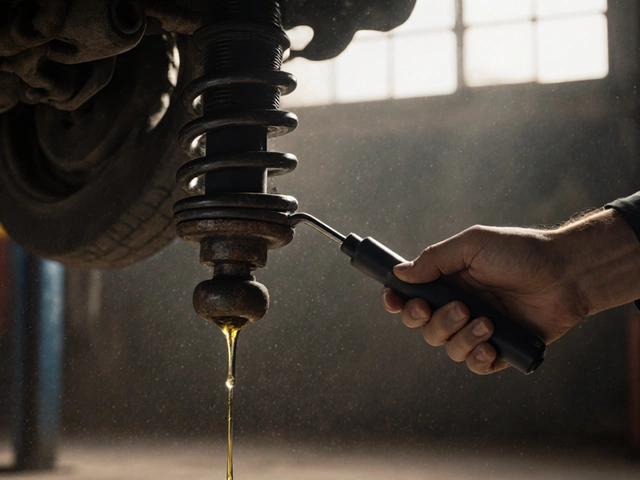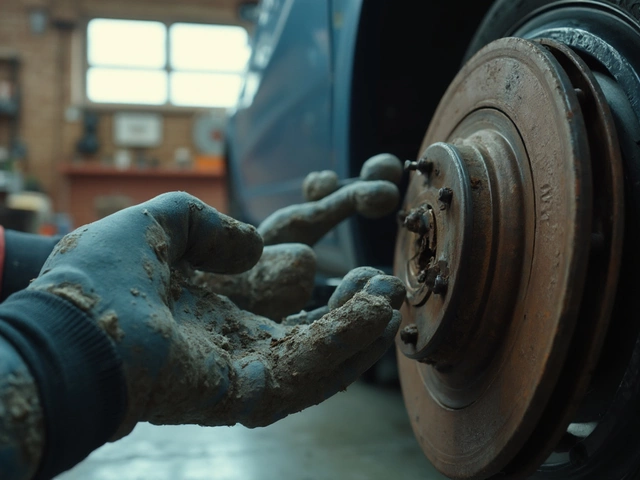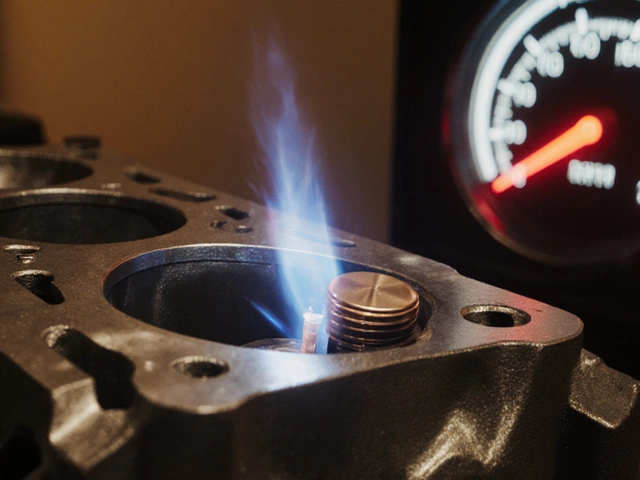Wiper Blade Size Checker
Check Your Correct Blade Sizes
Enter your vehicle details to get the exact blade sizes. Using incorrect sizes can cause damage and reduce visibility.
Your Correct Wiper Blade Sizes
- Wiper arm interference and screeching
- Blade lift-off at high speeds
- Damage to wiper motor and arms
- Partial windshield coverage
Most drivers don’t think twice about swapping out wiper blades-until they buy the wrong size and realize it doesn’t fit right. You’ve got a 16-inch wiper blade on your car, but you’re staring at a 17-inch one on the shelf. It’s only one inch bigger. Can you really use it? The short answer: sometimes, but not without risks.
Why Wiper Blade Size Matters
Wiper blades aren’t one-size-fits-all. Each car model has exact specifications for blade length, attachment type, and curvature. The manufacturer picks those numbers based on the shape of your windshield, the angle of the wiper arm, and how much area needs clearing. A 16-inch blade covers a specific zone. A 17-inch blade covers a slightly larger one. That extra inch might sound harmless, but in practice, it can cause real problems.Think of it like wearing shoes half a size too big. You can walk, sure-but you’ll trip, your toes will rub, and your feet will hurt by the end of the day. Same with wipers.
What Happens If You Put a 17-Inch Blade on a 16-Inch Mount
If you force a 17-inch blade onto a system designed for 16 inches, here’s what you’re likely to see:- Blade overlap or interference: The longer blade may bump into the opposite wiper arm during its swing. This causes screeching, skipping, or even damage to the rubber or metal arms.
- Blade lift-off: The wiper arm is calibrated for a certain weight and leverage. A longer blade adds extra force at the end, which can make it lift off the glass at highway speeds-leaving streaks or bare patches when you need them most.
- Arm stress: The wiper motor and arm are built to handle a specific load. A heavier, longer blade increases torque demand. Over time, this can wear out the motor, bend the arm, or break the pivot.
- Partial coverage: Surprisingly, a longer blade doesn’t always mean better cleaning. If the arm’s arc doesn’t reach far enough, you might end up with a gap at the top or bottom of the windshield where the blade can’t reach.
One driver in Bristol replaced their 16-inch blades with 17-inch ones after seeing them on sale. Within a week, the passenger-side arm started making a loud clicking noise. When they checked, the metal arm had bent slightly from the extra pressure. Repair cost: £85. New blades: £12.
When It Might Work (And Why You Should Still Avoid It)
There are rare cases where a 17-inch blade might fit a 16-inch mount. Some aftermarket blades come with adapters or flexible arms that let you trim or adjust the length. Others are marketed as “universal” and claim to fit multiple sizes.But here’s the catch: even if it physically fits, it’s not certified. Car manufacturers test wiper systems for safety, durability, and performance under extreme conditions-rain, ice, high speed, debris. A blade that’s not designed for your car breaks that chain of testing. If you get into an accident and poor visibility from misfit wipers is a factor, your insurance might not cover it.
Also, many modern cars have sensors for rain and automatic wiper activation. A blade that doesn’t match the original size can throw off the sensor calibration, causing delays or erratic wiping.

What to Do Instead
Don’t guess. Don’t wing it. Do this instead:- Check your owner’s manual. It lists the exact wiper blade sizes for front and rear.
- Look at the old blade. The size is printed on the metal frame or the rubber insert.
- Use a reliable online tool. Websites like AutoZone, Halfords, or RockAuto let you enter your car’s make, model, and year-they’ll show you the correct sizes.
- Buy exact replacements. Stick to the size listed. If you can’t find the exact model, choose a reputable brand that offers a direct fit (like Bosch, Rain-X, or Michelin).
There’s no savings worth risking your safety. A pair of 16-inch blades costs between £15 and £30. A damaged wiper arm or cracked windshield from a misfit blade? That’s hundreds.
Common Myths About Wiper Blade Sizes
- Myth: Bigger blade = better visibility.
Truth: Only if the design and arc match your windshield. A blade that’s too long just smears water sideways. - Myth: It’s fine if the blade doesn’t touch the edge.
Truth: The edge is where water pools. Missing that spot means your view stays blurry. - Myth: All 16-inch blades are the same.
Truth: There are different attachment types-hook, pin, side-lock. You need the right one for your car.

Real-World Example: A 2020 Toyota Corolla
A 2020 Toyota Corolla uses 26-inch driver-side and 16-inch passenger-side blades. Some people try to use a 17-inch on the passenger side because they think it’ll “cover more.” But the passenger-side arm is shorter, mounted lower, and has a tighter arc. A 17-inch blade will lift off at 50 mph and scrape the plastic trim around the windshield. The result? Not better vision-just noise, damage, and a $200 repair bill.Pro Tip: Replace Blades in Pairs
Even if only one blade is worn out, replace both. Wiper blades degrade at the same rate. If one is streaking, the other is close behind. Using mismatched blades-different sizes, brands, or ages-creates uneven wiping. That’s not just annoying. It’s dangerous.And don’t wait until you can’t see. Replace blades every 6 to 12 months, depending on weather. Sun, salt, and dust wear them down faster than you think. In the UK’s damp, gritty climate, 6 months is often the sweet spot.
Final Verdict
Can you use a 17-inch wiper blade instead of a 16-inch? Technically, maybe. Practically? No. The risks-damage to your car, reduced visibility, safety hazards-far outweigh any convenience or minor cost savings.Stick to the size your car was designed for. It’s not about being exact-it’s about being safe. Your windshield is your most important window to the road. Don’t risk it with a blade that doesn’t belong there.
Can I cut a 17-inch wiper blade to make it fit a 16-inch mount?
No. Cutting a wiper blade damages the internal spring mechanism and rubber seal. Even if you trim the rubber, the metal frame won’t flex correctly, leading to uneven pressure and streaking. Never modify wiper blades-always use the correct size.
Will a 17-inch blade work if my car takes 16-inch and 18-inch blades?
No. If your car uses two different sizes (like 16-inch driver and 18-inch passenger), each side is designed for a specific arc and leverage. Using a 17-inch on the 16-inch side still creates imbalance and potential interference. Stick to the exact sizes listed in your manual.
Are universal wiper blades safe to use?
Universal blades can work if they’re properly adjusted and secured with the correct adapter. But many are poorly made, with weak springs or cheap rubber. For safety-critical parts like wipers, direct-fit blades from trusted brands are always better than “one-size-fits-most” options.
Why do some online stores list 17-inch blades as compatible with 16-inch mounts?
Some retailers use loose compatibility filters. They might say “fits vehicles with 16-18 inch blades” to boost sales. That doesn’t mean it’s safe or correct for your specific model. Always cross-check with your vehicle’s make, model, and year using a trusted auto parts site.
What happens if I use the wrong size for just a few weeks?
Even short-term use can cause damage. A misfit blade can bend the wiper arm, wear down the motor, or scratch the windshield from uneven pressure. Streaking reduces visibility in rain-making every drive riskier. Don’t risk it, even temporarily.






